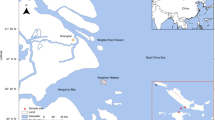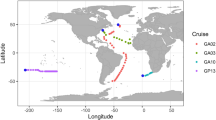Abstract
Picorna-like viruses are a loosely defined group of positive-sense single-stranded RNA viruses that are major pathogens of animals, plants and insects. They include viruses that are of enormous economic and public-health concern and are responsible for animal diseases (such as poliomyelitis1), plant diseases (such as sharka2) and insect diseases (such as sacbrood3). Viruses from the six divergent families (the Picornaviridae, Caliciviridae, Comoviridae, Sequiviridae, Dicistroviridae and Potyviridae) that comprise the picorna-like virus superfamily4 have the following features in common: a genome with a protein attached to the 5′ end and no overlapping open reading frames, all the RNAs are translated into a polyprotein before processing, and a conserved RNA-dependent RNA polymerase (RdRp) protein. Analyses of RdRp sequences from these viruses produce phylogenies that are congruent with established picorna-like virus family assignments5,6,7; hence, this gene is an excellent molecular marker for examining the diversity of picorna-like viruses in nature. Here we report, on the basis of analysis of RdRp sequences amplified from marine virus communities, that a diverse array of picorna-like viruses exists in the ocean. All of the sequences amplified were divergent from known picorna-like viruses, and fell within four monophyletic groups that probably belong to at least two new families. Moreover, we show that an isolate belonging to one of these groups is a lytic pathogen of Heterosigma akashiwo, a toxic-bloom-forming alga responsible for severe economic losses to the finfish aquaculture industry, suggesting that picorna-like viruses are important pathogens of marine phytoplankton.
This is a preview of subscription content, access via your institution
Access options
Subscribe to this journal
Receive 51 print issues and online access
$199.00 per year
only $3.90 per issue
Buy this article
- Purchase on Springer Link
- Instant access to full article PDF
Prices may be subject to local taxes which are calculated during checkout

Similar content being viewed by others
References
Pallansch, M. A. & Roos, R. P. in Fields Virology (eds Knipe, D. M. & Howley, P. M.) 723–775 (Lippincott, Williams & Wilkins, Philadelphia, 2001)
Lazarowitz, S. G. in Fields Virology (eds Knipe, D. M. & Howley, P. M.) 533–598 (Lippincott, Williams & Wilkins, Philadelphia, PA, 2001)
Bailey, L., Gibbs, A. J. & Woods, R. D. Sacbrood virus of the larval honey bee (Apis mellifera Linnaeus). Virology 23, 425–429 (1964)
Liljas, L. et al. Evolutionary and taxonomic implications of conserved structural motifs between picornaviruses and insect picorna-like viruses. Arch. Virol. 147, 59–84 (2002)
Koonin, E. V. & Dolja, V. V. Evolution and taxonomy of positive-strand RNA viruses - implications of comparative-analysis of amino-acid-sequences. Crit. Rev. Biochem. Mol. Biol. 28, 375–430 (1993)
Zanotto, P. M. D., Gibbs, M. J., Gould, E. A. & Holmes, E. C. A reevaluation of the higher taxonomy of viruses based on RNA polymerases. J. Virol. 70, 6083–6096 (1996)
Mari, J., Poulos, B. T., Lightner, D. V. & Bonami, J. R. Shrimp Taura syndrome virus: genomic characterization and similarity with members of the genus Cricket paralysis-like viruses. J. Gen. Virol. 83, 915–926 (2002)
Fuhrman, J. A. Marine viruses and their biogeochemical and ecological effects. Nature 399, 541–548 (1999)
Wilhelm, S. W. & Suttle, C. A. Viruses and nutrient cycles in the sea. Bioscience 49, 781–788 (1999)
Suttle, C. A. in Viral Ecology (ed. Hurst, C. J.) 248–286 (Academic, San Diego, CA, 2000)
Wommack, K. E. & Colwell, R. R. Virioplankton: viruses in aquatic ecosystems. Microbiol. Mol. Biol. Rev. 64, 69–114 (2000)
Mann, N. H. Phages of the marine cyanobacterial picophytoplankton. FEMS Microbiol. Rev. 27, 17–34 (2003)
Bernard, J. & Bremont, M. Molecular biology of fish viruses — a review. Vet. Res. 26, 341–351 (1995)
Van Bressem, M. F., Van Waerebeek, K. & Raga, J. A. A review of virus infections of cetaceans and the potential impact of morbilliviruses, poxviruses and papillomaviruses on host population dynamics. Dis. Aquat. Organ. 38, 53–65 (1999)
Smith, A. in Viral Ecology (ed. Hurst, C.) 447–491 (Academic, San Diego, CA, 2000)
Poch, O., Sauvaget, I., Delarue, M. & Tordo, N. Identification of four conserved motifs among the RNA-dependent polymerase encoding elements. EMBO J. 8, 3867–3874 (1989)
Koonin, E. V. The phylogeny of RNA-dependent RNA polymerases of positive-strand RNA viruses. J. Gen. Virol. 72, 2197–2206 (1991)
Suttle, C. A., Chan, A. M. & Cottrell, M. T. Use of ultrafiltration to isolate viruses from seawater which are pathogens of marine phytoplankton. Appl. Environ. Microbiol. 57, 721–726 (1991)
Altschul, S. F. et al. Gapped BLAST and PSI-BLAST: a new generation of protein database search programs. Nucleic Acids Res. 25, 3389–3402 (1997)
Kingsley, D. H., Meade, G. K. & Richards, G. P. Detection of both hepatitis a virus and Norwalk-like virus in imported clams associated with food-borne illness. Appl. Environ. Microbiol. 68, 3914–3918 (2002)
Kamer, G. & Argos, P. Primary structural comparison of RNA-dependent polymerases from plant, animal and bacterial viruses. Nucleic Acids Res. 12, 7269–7282 (1984)
Tai, V. et al. Characterization of HaRNAV, a single-stranded RNA virus causing lysis of Heterosigma akashiwo (Raphidophyceae). J. Phycol. 39, 343–352 (2003)
Smayda, T. J. in Physiological Ecology of Harmful Algal Blooms (eds Anderson, D. M., Cembella, A. D. & Hallegraeff, G. M.) 113–131 (Springer, Berlin, GER, 1998)
Suttle, C. A. & Chen, F. Mechanisms and rates of decay of marine viruses in seawater. Appl. Environ. Microbiol. 58, 3721–3729 (1992)
Smith, A. W., Akers, T. G., Madiu, S. H. & Vedros, N. A. San Miguel sea lion virus isolation, preliminary characterization and relationship to vesicular exanthema of swine virus. Nature 244, 108–110 (1973)
Short, S. M. & Suttle, C. A. Sequence analysis of marine virus communities reveals that groups of related algal viruses are widely distributed in nature. Appl. Environ. Microbiol. 68, 1290–1296 (2002)
Thompson, J. D. et al. The CLUSTAL_X windows interface: flexible strategies for multiple sequence alignment aided by quality analysis tools. Nucleic Acids Res. 24, 4876–4882 (1997)
Whelan, S. & Goldman, N. A general empirical model of protein evolution derived from multiple protein families using a maximum-likelihood approach. Mol. Biol. Evol. 18, 691–699 (2001)
Schmidt, H. A., Strimmer, K., Vingron, M. & von Haeseler, A. TREE-PUZZLE: maximum likelihood phylogenetic analysis using quartets and parallel computing. Bioinformatics 18, 502–504 (2002)
Fitch, W. M. & Margoliash, E. Construction of phylogenetic trees. Science 155, 279–284 (1967)
Acknowledgements
We thank the crew and participants of the SOG cruises from 1996 to 1998. We also thank C. Frederickson for assistance with DGGE and M. Berbee and P. Keeling for advice on phylogenetic analyses. This work was supported by a National Science and Engineering Research Council of Canada grant to C.A.S.
Author information
Authors and Affiliations
Corresponding author
Ethics declarations
Competing interests
The authors declare that they have no competing financial interests.
Supplementary information
Rights and permissions
About this article
Cite this article
Culley, A., Lang, A. & Suttle, C. High diversity of unknown picorna-like viruses in the sea. Nature 424, 1054–1057 (2003). https://doi.org/10.1038/nature01886
Received:
Accepted:
Issue Date:
DOI: https://doi.org/10.1038/nature01886
This article is cited by
-
Expanding known viral diversity in plants: virome of 161 species alongside an ancient canal
Environmental Microbiome (2022)
-
Complete genome analysis of a novel picorna-like virus from a ladybird beetle (Cheilomenes sexmaculata)
Archives of Virology (2022)
-
Virus-host relationships of marine single-celled eukaryotes resolved from metatranscriptomics
Nature Communications (2017)
-
Virus–host interactions and their roles in coral reef health and disease
Nature Reviews Microbiology (2017)
-
Rising to the challenge: accelerated pace of discovery transforms marine virology
Nature Reviews Microbiology (2015)
Comments
By submitting a comment you agree to abide by our Terms and Community Guidelines. If you find something abusive or that does not comply with our terms or guidelines please flag it as inappropriate.



